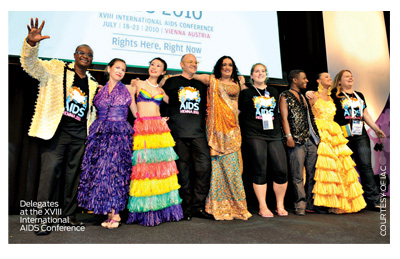This past July, experts in the fields of HIV/AIDS science, policy and activism, as well as HIV-positive people, journalists, government officials, religious leaders and the staffs of AIDS service organizations gathered in Vienna for the XVIII International AIDS Conference.
POZ and AIDSmeds were there, covering everything from breaking treatment and advocacy news to the latest reports on vaccines, new drugs in the development pipeline, microbicides, criminalization and condoms. Log on to poz.com/aids2010 for our extensive coverage. In the meantime, we’ve compiled some HIV treatment and prevention highlights from this year’s confab:
 |
When to Start? Current HIV treatment recommendations—start when CD4s fall below 500—are on the mark in terms of reducing the risk of AIDS or death, according to results from the CASCADE cohort study. No benefit was seen among those starting with 500 or more CD4s over the three-year study period, though it is possible a benefit may become apparent over a longer period of time.
Spare Me. Two novel regimens showed promise in Vienna: Reyataz plus Isentress (without Norvir or nukes) and Kaletra plus Isentress (without nukes). While not yet ready for prime time, both regimens are proving comparable with standard combos. Isentress resistance is of concern, however.
Dueling Nukes. Epzicom appears to work just as well as Truvada as components of first-line therapy, according to a Canadian study. These findings challenge earlier trials suggesting that Truvada trumps Epzicom in patients with high pre-treatment viral loads.
New Drug News. ViiV’s integrase inhibitor S/GSK-572 is performing well in a first-time treatment study and shows potential for some people with Isentress-resistant HIV. Tibotec’s non-nuke rilpivirine had similar efficacy and fewer side effects than Sustiva in two clinical trials, though the potential for HIV resistance to non-nuke Intelence is worrisome. And making its data debut was Boehringer Ingelheim’s Viramune XR—an extended release, once-daily version of the non-nuke.
Treatment as Prevention. A vaginal microbicide containing the nuke tenofovir cut HIV infection rates by 39 percent in a clinical trial of nearly 900 South African women. Among those who used the gel correctly at least 80 percent of the time they had intercourse, HIV transmission rates were slashed 54 percent. Watch for studies using a two-drug gel—tenofovir and emtricitabine—and similar microbicides for anal use.






Comments
Comments